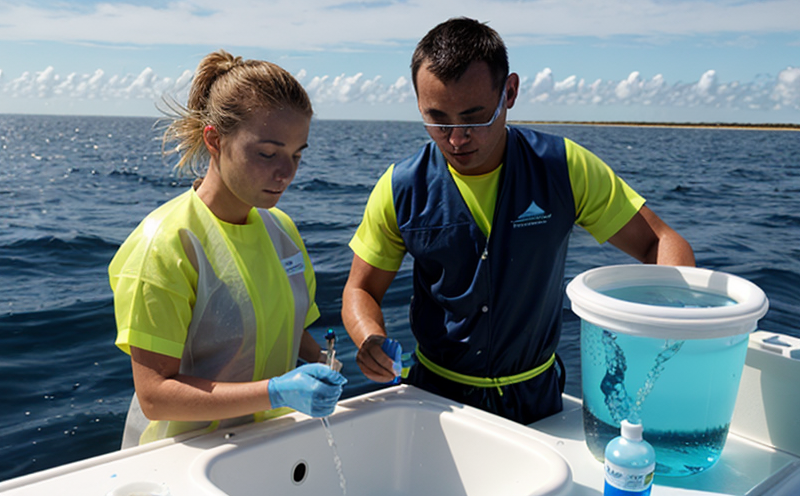APHA 2320B Total Alkalinity Test in Seawater
The APHA 2320B method is a widely recognized procedure used to determine total alkalinity in seawater. This test is crucial for ensuring the quality and safety of water, particularly important in marine environments where pH stability can impact various processes including corrosion control, biofouling prevention, and the health of aquatic ecosystems.
Total alkalinity represents the combined capacity of a solution to neutralize acids. In seawater, it plays a significant role in maintaining the buffering capacity necessary for supporting life forms and ensuring industrial processes proceed smoothly without excessive corrosive effects. The APHA 2320B method is based on titration with strong acid (usually sulfuric or nitric), using phenolphthalein as an indicator. This standard procedure ensures accurate measurement of total alkalinity, which can vary widely depending on the composition of the seawater.
The importance of this test extends beyond just environmental and industrial considerations; it also has implications for public health and safety. For instance, in recreational areas or near coastal structures, understanding total alkalinity helps prevent issues like skin irritation due to overly alkaline water conditions. Similarly, in offshore operations, controlling pH through the management of total alkalinity can protect expensive equipment from corrosion.
The procedure outlined in APHA 2320B is designed for a wide range of sample types, including surface seawater, brackish waters, and process waters used in desalination plants. However, specific conditions may require adjustments to the standard protocol; these could involve dilution factors or temperature corrections.
Given its critical role, this method has been adopted by numerous international standards bodies such as ASTM, ISO, and others. It is particularly relevant for sectors including marine biology research, coastal engineering, and desalination facilities. By adhering to the APHA 2320B protocol, laboratories ensure their data are consistent with global benchmarks, enhancing trustworthiness and reliability.
For accurate results, proper sample collection and preparation are essential. This includes ensuring that samples are representative of the larger body of water from which they were taken. Once collected, samples should be kept cool and analyzed as soon as possible to avoid any pH changes due to microbial activity or exposure to air.
Why It Matters
The total alkalinity in seawater is a key parameter that influences many aspects of marine ecology and industrial operations. A balanced alkalinity level supports the health of marine organisms, maintains optimal pH conditions for coral reefs and other sensitive ecosystems, and prevents excessive corrosion in metal structures exposed to seawater.
- Supports Marine Ecosystem Health: Alkalinity levels help regulate pH, which is crucial for maintaining biodiversity and preventing acidification that can harm aquatic life.
- Prevents Corrosion: In industrial settings, particularly near coastal areas or in desalination plants, monitoring total alkalinity helps mitigate corrosion risks associated with seawater exposure.
- Promotes Water Quality: Ensuring appropriate levels of alkalinity enhances water quality by reducing the risk of harmful algal blooms and other environmental stressors.
Understanding these factors underscores why accurate measurement is paramount. The APHA 2320B method provides a reliable way to achieve this, making it indispensable for both scientific research and practical applications in marine environments.
Applied Standards
| Standard | Description |
|---|---|
| APHA 2320B | Determines total alkalinity in water, including seawater. It involves titration with sulfuric or nitric acid and phenolphthalein as an indicator. |
| ASTM D1141-18 | Standard test method for determination of free carbon dioxide in water by potentiometric titration. Useful when assessing total alkalinity alongside other parameters. |
| ISO 7027:1993(E) | Method of sampling and preparation of seawater samples for chemical analysis, ensuring that the sample collected is representative of the larger body of water. |
The APHA 2320B method is complemented by other standards like ASTM D1141-18 which helps in assessing free carbon dioxide levels alongside total alkalinity. These methods ensure comprehensive evaluation of seawater quality parameters, providing a holistic view necessary for effective management.
International Acceptance and Recognition
- The APHA 2320B method has been adopted by numerous international standards bodies including ASTM, ISO, and EN.
- This standard is widely used in countries around the world to ensure consistent and accurate measurements of total alkalinity in seawater.
Its acceptance spans various sectors such as environmental monitoring, coastal engineering, marine biology research, and desalination plant operations. The widespread use of this method underscores its reliability and importance in maintaining global standards for seawater quality.
By adhering to these international standards, laboratories ensure their results are comparable across different regions and countries, fostering trust among stakeholders including government agencies, academic institutions, and industry partners.





